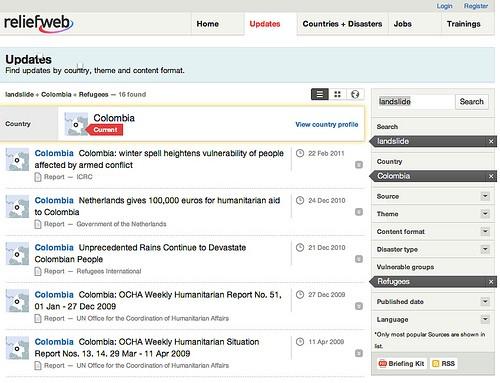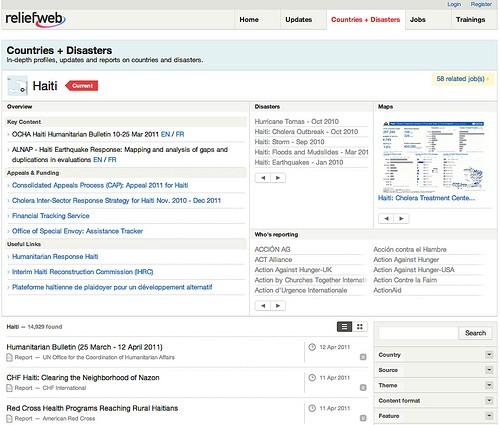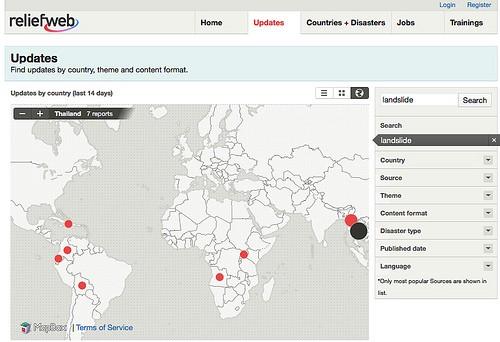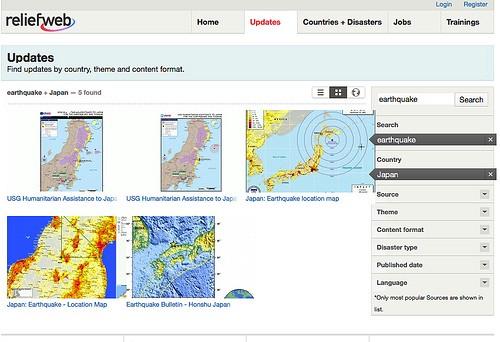ReliefWeb is one of the largest repositories of humanitarian relief information available online, giving hundreds of thousands of humanitarian workers access to first hand reports from emergency zones, training resources, and the latest employment opportunities each year. It’s a particularly indispensable resource when disaster strikes, having provided more than 386,000 reports from more than 2,200 disasters at the time of this posting. Needless to say, we’re proud to have helped build the new home for such an important service.
With today’s launch of ReliefWeb.int, I’ll walk through the site’s top features and our thinking around them.
Flat information architecture through search
A main goal of the relaunch was to help relief workers find content faster. Faceted search allowed us to consolidate the information architecture into three searchable rivers for reports (updates), jobs, and trainings. Search, coupled with filter options that show the number of results ahead of time, make for a very powerful user interface for drilling down on posts, alleviating the need for more heavy handed hierarchical navigations.

Flexible profiles
From search results, users can quickly click through to profile pages on specific countries or disasters. These profiles provide editorial control over introductory texts and featured posts, and are crucial tools in emergency situations where a high volume of content needs to be sifted and highlighted to a humanitarian relief community working under the pressure of unfolding events.


Maps
We’re using interactive maps to provide geographical overviews on the front page and on landing pages throughout the site. Beyond that search results can be displayed on a map, giving a quick overview of the geographical distributions for any search of recent content. For all maps, we are using a UN specific MapBox tileset that properly reflects disputed border areas. The tiles are hosted on MapBox’s new TileStream Hosting, something we will be talking about a lot more in the coming weeks.

Infographics
The UN produces highly detailed infographics, usually in the form of one-page PDFs designed to explain complex situations happening on the ground. The new search interface offers a thumbnail mode to give users a visually rich view of the available content.

Briefing Kit
The Briefing Kit is designed to equip humanitarian aid workers with a way to compile information to be read offline. In its original version, users had to configure their Briefing Kits with a search interface distinct from the rest of the site. The new site offers an integrated approach by providing any search result as a Briefing Kit download — further simplifying the information architecture. The download not only contains reports themselves, but any PDF attachment that they contain.
Improved submission workflows
Fraudulent job posts were a major issue on the previous version of ReliefWeb’s site. As jobs were submitted via email, the identity and good intentions of a sender could only be tied to the sender email of the submitter. The new site requires users to have an account on reliefweb.int for submitting vacancies and submissions continue to be moderated by ReliefWeb staff. This allows for a safer assumption of a user’s identity (it’s harder to hack an account than to use a fake email sender address), and therefore a more integrated management of trust. Additionally, reliable users can now be promoted to a status that allows them to post vacancies directly, removing a significant burden from ReliefWeb’s editorial team.
Deployment and hosting
We worked with Blackmesh to spec out and host ReliefWeb’s infrastructure. In all ReliefWeb hosts about 400,000 pieces of content and 150,000 user accounts. However given the relatively limited amount of logged on users at any given time, a setup of one beefy database, a solid web head, and Varnish as a reverse proxy cache is sufficient.
Launch and support
Wiredcraft handled the launch and support of ReliefWeb.int. In the last couple of weeks their team helped finalize the content migration, train staff, and ensure a smooth transition to the new site. Going forward, Wiredcraft will troubleshoot day to day issues and help ReliefWeb expand and improve upon the newly launched site by adjusting and adding features.
Agile approach
The ReliefWeb team completely embraced our agile approach of building in fast iterations based on clearly stated intentions with multiple rounds of reviews and adjustments. This synergy played a huge role in the project’s ultimate success, allowing us to spend the majority of our time building the site and meeting the project’s goals.
We rolled out multiple versions of the site, underwent several review processes, and made many adjustments to get to the version that is live right now. Of course there are still ideas for improvements that didn’t make it into Phase 1. In the agile spirit, we have set up ReliefWeb with a site that can continue to be improved and adjusted as their mission develops and changes.
Under the hood
Here is a quick look at what is powering ReliefWeb.int.
-
Sphinx for search
-
OpenLayers for map interactivity
-
Mapbox.com for map tiles
-
Feeds for content migration
-
Varnish as a reverse proxy
-
Server hardware:
-
Web: Intel Xeon Quad Core 5520, 24GB RAM
-
Database: Intel Xeon Quad Core 5520, 24GB RAM, 36GB RAM, 4 x 300 GB Serial Attached SCSI, Raid 1
What we're doing.
Latest
